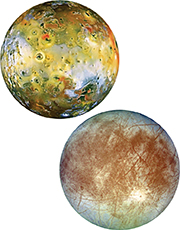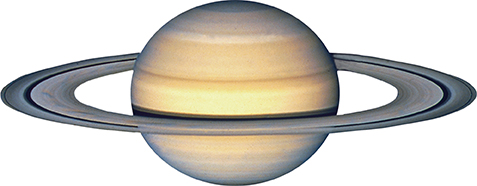Jupiter's Atmosphere
With many colorful bands of clouds, Jupiter has a striking appearance. Jupiter's clouds move rapidly because Jupiter itself rotates rapidly—one day on Jupiter is less than 10 Earth hours. The brown cloud bands are colder and move faster around the planet than the white bands.
Sometimes storms occur at the boundaries between these brown and white bands. One example is the Great Red Spot, a huge storm that rotates around its own center like a hurricane. It is caught between two bands of winds blowing in opposite directions. On Earth, a hurricane changes and dissipates when it travels from water to land. Because there is no land on Jupiter, such storms can last for many years. The Great Red Spot, for example, was first observed in 1664, but may be much older.
Jupiter's Moons
Jupiter has at least 63 moons. Most of them are small, less than 200 kilometers in diameter. However, two of them, Ganymede and Callisto, are similar in size to Mercury. Two others, Io and Europa, are somewhat smaller, about the size of our moon. Ganymede, Io, and Europa have metal cores and rocky mantles. Io, shown in Figure 22, is covered with actively erupting volcanoes. Ganymede, Europa, and Callisto are covered with ice. On Europa, also shown in Figure 22, the icy crust appears to rest on top of a liquid saltwater ocean. Because of this, scientists hypothesize that Europa is the most likely place in the solar system, other than Earth, to support life.
Saturn
Saturn, the second largest planet in the solar system, is best known for its rings.  Saturn's rings are the largest and most visible from Earth. The rings are made of particles of ice and ice-coated rock. These particles are generally between a few micrometers and 10 meters across, with most particles being snowball-sized. The rings are about 274,000 kilometers in diameter, yet are only tens of meters thick.
Saturn's rings are the largest and most visible from Earth. The rings are made of particles of ice and ice-coated rock. These particles are generally between a few micrometers and 10 meters across, with most particles being snowball-sized. The rings are about 274,000 kilometers in diameter, yet are only tens of meters thick.
Figure 22 Two of Jupiter's larger moons are Io (top) and Europa (bottom). Io is the most volcanically active body in the solar system. Io's volcanic eruptions consist mainly of liquid sulfur. Europa may have a liquid water ocean beneath its icy surface. The dark lines are wide fractures in Europa's crust. Formulating Hypotheses
Would you expect many impact craters on Io's surface? Explain why or why not.

Figure 23 Saturn has a thick atmosphere. It is surrounded by a spectacular set of rings, the largest in the solar system.





